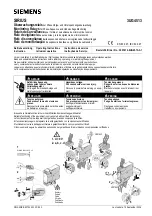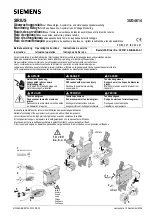
3UG4.1 line monitoring relay
6.2 3UG4511 line monitoring relay
3UG4 / 3RR2 monitoring relays
104
Manual, 05/2016, NEB927043002000/RS-AC/004
6.2.2
Function
General functionality
The 3UG4511 line monitoring relays monitor the phase sequence in a three-phase system.
The devices are self-powered (measuring voltage = rated control supply voltage) and work
on the closed-circuit principle. Depending on the version, the line monitoring relays are
powered with a rated control supply voltage of 160 V to 260 V (3UG4511-..N20), 320 to
500 V (3UG4511-..P20) and 420 to 690 V (3UG4511-..Q20) through terminals L1 / L2 / L3.
All 3UG4511 line monitoring relays feature at least one output relay (output relay K1 CO
contact). The 3UG4511-.B line monitoring relays have an additional relay (output relay K2
CO contact). Output relay K2 switches synchronously with output relay K1.
No settings are required for operation.
Note
The specified voltages represent the absolute thresholds.
Monitoring
If the correct phase sequences are applied to terminals L1-L2-L3, the output relay picks up
after the response time and the "contact symbol" LED lights up green. If the phase sequence
is incorrect, the output relay remains in its quiescent position. After the power system has
been disconnected, the output relays drop out after the response time has expired.
Note
After failure of one phase, motors generate a reverse voltage at the terminal of the failed
phase due to the regenerative power recovery. This can be up to 90 % of the line voltage in
magnitude. Because the 3UG4511 line monitoring relays are not protected against reverse
voltage, such a phase failure is not reliabily detected.
If this type of monitoring is required, the 3UG4512 line monitoring relay should be used, for
example!
You will find the switching states of the output relays below in section "Function diagrams"
and in Chapter "Diagnostics (Page 105)."
Reset response
The device features an autoreset that resets the output relay to its original state after an
error message and rectification of the fault that has occurred.
















































